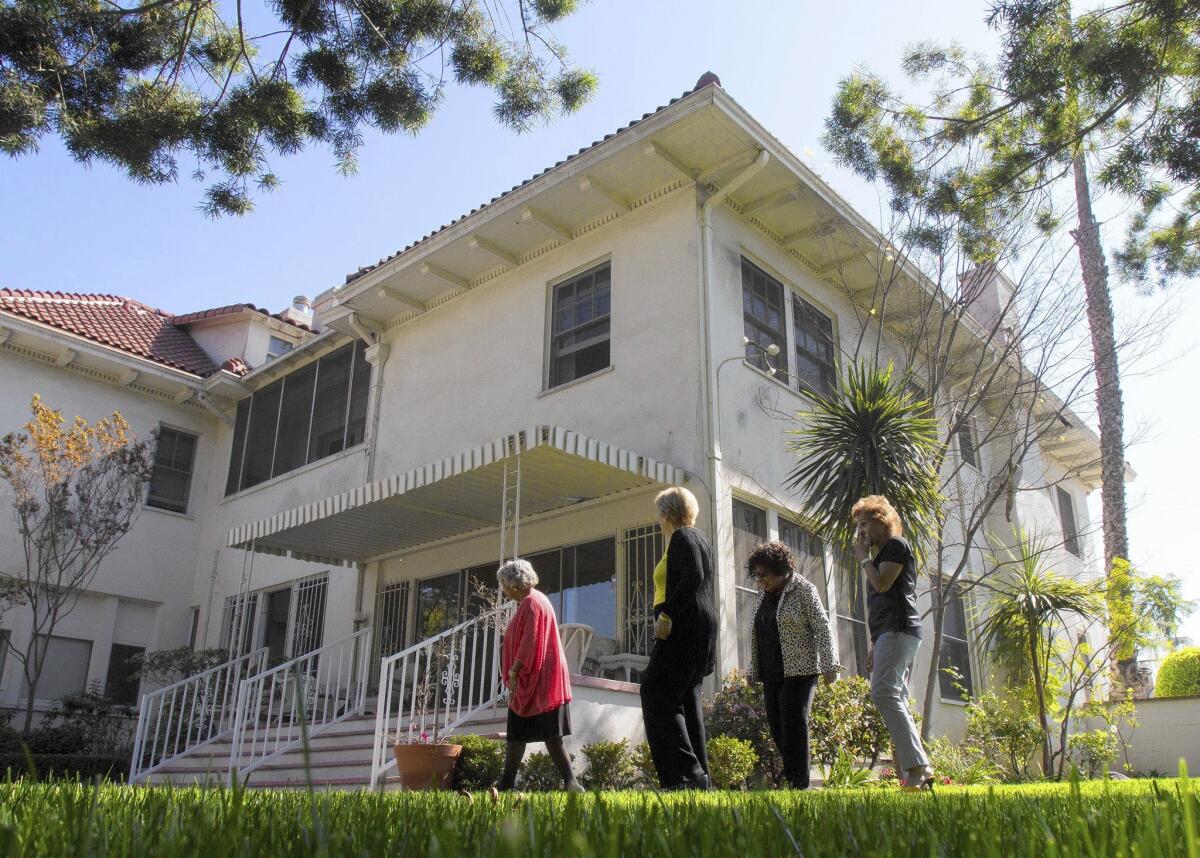Restoring the luster of a centerpiece of black history

Sixty years ago, the Wilfandel House in the West Adams district was a hub of high society for black Los Angeles.
Back then, Negroes couldn’t book rooms in posh hotels or upscale party venues. So the wives of dozens of successful black men formed a club and purchased a home in what then was one of the city’s wealthiest neighborhoods.
“Everybody who was anybody who lived in L.A. or came through town was entertained at the Wilfandel,” recalled Heilindia Brown, a former club president. The spot was known across the country for its elegant parties, lavish receptions and intimate concerts.
But times changed and barriers fell. Integration blurred class distinctions and broadened social options. And the once-grand Wilfandel lost its niche among a new generation of black Angelenos unfamiliar with being shut out.
Now the stately manse, with its servants’ quarters and carriage house, is a fading emblem of black history in a multiethnic city. And the aging grand dames of the Wilfandel Club are wielding hammers, paintbrushes and mops to reclaim its legacy.
::
Brown, 76, was toting a bucket and mop and hauling giant potted plants when I met her at the Wilfandel last fall. She’s a retired flight attendant who joined the club for the sisterhood, then fell in love with the house.
“I’ve installed Venetian blinds. I have painted. I hang drapes. I wash linens,” she said. “I will do whatever it takes to make sure this house does not fall by the wayside.”
The project is a labor of love for ladies who look like they belong in pearls and white gloves instead of dungarees.
Many club members, like Narvia Shannon, are old enough to have been confronted with segregation’s restrictions.
It wasn’t the kind of overt racism that Southern transplants had experienced. “It was more like social prejudice,” the 78-year-old said. “Everyone knew their place, where you could and couldn’t go. We learned that as children.”
She remembers when a white barber in the Crenshaw district refused to cut her cousin’s hair and suggested she take the little boy to the black neighborhood along Central Avenue. “The barber was very polite,” she recalled. “Just said he couldn’t do it. So we took the bus to Central.”
The Wilfandel House was a sanctuary from that kind of rejection, said Shannon, a retired teacher. “People who came here just wanted to work and enjoy the benefits of a social life with elegance and dignity.”
::
The Wilfandel Club itself is more middle-class now than it was in 1945. New members still must have two sponsors and get unanimous approval. But acceptance depends on a woman’s civic commitment, not her husband’s credentials.
There are 48 members — mostly teachers, social workers, lawyers, psychologists and other professionals. The youngest are in their 40s, the oldest in their 90s.
The house unfortunately is not aging as gracefully as its owners. The front lawn is patchy, the curtains are faded and it’s flanked by once-grand homes that have been carved up into apartments.
But restoration projects are underway: The backyard has a new lush lawn; the central heating has been replaced; new drapes were ordered this week.
For decades, the Wilfandel was so flush with cash that it funded arts programs, a summer camp, projects with community groups and scholarships for college students. It still does some of that. But club dues and event rental fees barely cover upkeep for the 100-year-old, 6,240-square-foot home.
The group is soliciting contributions, hoping to turn the house into more of a community asset. As the makeup of the neighborhood became older and more Latino, bridal showers and bridge club meetings were replaced by quinceañeras and funeral repasts.
Many members are old enough to remember the Wilfandel’s glory days, when the calendar was crowded with parties, concerts, wedding receptions and book club gatherings.
“The women wore hats, gloves and high heels,” recalled Anne Luke, 77, who as a child attended Wilfandel tea parties with her mother. “When they leaned down to hug you, you’d wind up dusted with talcum powder.
“It was like a lovely hotel, where everyone was so pretty and gracious and charming. You had to be on your best behavior. They taught us that manners mattered.”
Now Luke and her club members are hoping that history also matters.
“We’re trying to preserve a place that young people just don’t seem to be interested in,” Brown said. “We know we have to make it relevant to a younger generation. … If you grew up in Los Angeles, this is your history too.”
More to Read
Start your day right
Sign up for Essential California for news, features and recommendations from the L.A. Times and beyond in your inbox six days a week.
You may occasionally receive promotional content from the Los Angeles Times.







